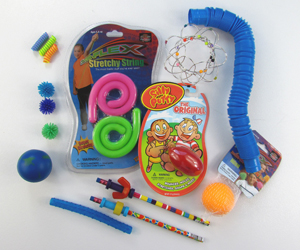
Children who have autism spectrum disorders may have sensory issues that impact getting ready in the morning and school functioning. Here are 10 strategies to help them ease into the school day and while they are there.

1) Select school clothes the night before. Tagless and compression-style clothing are often good choices. Turning
socks/underwear inside out, or letting your child sleep in the clothes for the next day can be a big help!
2) Begin your morning with deep pressure massage, calming/alerting music, and/or movement input (animal walks to
breakfast, jumping jacks, swinging, etc.).
3) Sensory-friendly classrooms are important. Natural lighting and/or light covers for fluorescent lights are helpful. Make teachers aware that overcrowded walls and strong smells (perfume, deodorant, or food) may be overstimulating for children with hypersensitivities. Sensory earmuffs can help with noise reduction.
4) Encourage seating alternatives like ball chairs and air cushions to provide calming/alerting movement input.

5) Incorporate movement and deep pressure throughout the day with classroom chores (stacking chairs, erasing whiteboards, delivering library books, etc.). Do warm-up activities like jumping jacks or “Simon Says” before sedentary activities.
6) Use weighted and deep pressure tools (weighted vests, lap pads, pressure vests, compression clothing, or weighted
backpacks) to provide calming, organizing input throughout the day.
7) Oral input creates rhythm and is a powerful sensory regulator. Incorporate water bottles, gum, crunchy snacks, chewy pencil toppers, chewable jewelry, etc.
8) Subtle, silent classroom fidgets can be effective in keeping restless fingers busy, bodies relaxed, and minds focused! Ask your OT!
9) Children with sensory issues often have difficulty standing in line because of tactile hypersensitivity or may struggle in the cafeteria due to the noise or smells. Educate lunchroom aides, bus drivers, teachers, and paraprofessionals about your child’s specific sensory needs. Be sure sensory responses aren’t being misinterpreted as behavior issues. Your child may benefit from changing classes early, having an assigned bus seat up front, and getting on the bus last and off first. A 10-minute break after lunch in a quiet, separate space can provide an easy way to reset your child’s nervous system.
10) Every child is a gift! Help others recognize your child’s uniqueness and celebrate it!
________
Jan Artman LaPrade, MS, OTR/L has been an OT for over 20 years, working in the schools for most most of her career. She is a married mom of three children who have sensory and learning differences, and is a staff occupational therapist at the Therapy Shoppe®, a pediatric therapy company that specializes in innovative sensory tools, learning toys, and other favorite products for children who have special needs.

